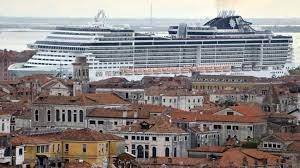 Cruise ships will still be docking in Venice, as a result of a temporary solution that re-routes big ships away from the fragile canal that skirts the historic city.
Cruise ships will still be docking in Venice, as a result of a temporary solution that re-routes big ships away from the fragile canal that skirts the historic city.
According to a Cruisington Times report by Walter Immen, temporary landing places are being set up to accommodate up to 10 cruise ships at the Venice Ro-Port Mos Terminal in Fusina, and also three other cargo berths are being identified, with ships under 180 meters, about 600 feet, are still allowed to reach the Venezia Terminal Passeggeri Stazione Marittima through the San Marco Basin and the Giudecca Canal.
Hapag-Lloyd Cruises’ Europa 2 was the first to use the cargo terminal on September 2 and Silversea’s Silver Shadow on September 8 to be followed by Holland America Line’s Eurodam.
The report says it’s a compromise to salvage the Autumn cruise schedule following an August 1 decree banning all ships from the city, but it’s not the final answer.
Fulvio Lino Di Blasio, president of the North Adriatic Sea Port Authority said, “Thanks to the collaboration and commitment of each player, we have been able to recover 50 percent of this year’s cruise schedule,” adding, “This is only the first step of a concrete path; next autumn will find us committed to giving a sustainable future to the cruise sector in Venice”, and “This is all done by keeping in mind that a vast community was largely damaged in terms of jobs in a very complex historical framework for our port, in which it is essential to operate in an organized manner, and by joining forces.”
Vessels banned from the maritime cruise complex are those with a hull length at waterline exceeding 180 meters or 600 feet, which for example is the length of Oceania’s mid-size R-class ships, with Europa 2 is 780 feet long and Eurodam over 900 feet.
 The report says that there are good reasons to set limits, with after the collision of a cruise ship and a smaller tourist boat in Venice in June, 2019, Italy’s transport minister Danilo Toninelli told a parliamentary hearing that cruise ships would be rerouted away from the city center “to avoid witnessing more invasions … by these floating palaces, with the scandals and risks they bring.”
The report says that there are good reasons to set limits, with after the collision of a cruise ship and a smaller tourist boat in Venice in June, 2019, Italy’s transport minister Danilo Toninelli told a parliamentary hearing that cruise ships would be rerouted away from the city center “to avoid witnessing more invasions … by these floating palaces, with the scandals and risks they bring.”
The report adds that it’s a long-overdue concession to reality that the once-serene city needs to set limits on the growth of tourism that’s creating pedestrian traffic jams on the city’s narrow lanes and ancient bridges as well as its fabled canals and it’s logical to put the brakes on a trend that was seeing ships taller than anything in the city looming over monuments and sometimes causing flooding in their wakes.
We may all recall that the government has been announcing plans to rid the city of cruise ships for a decade, with a 2014 proposal to ban ships over 96,000 tons bogged down in appeals and was overturned by Italy’s courts, although the cruise industry imposed that limit on its ownm which still allowed ships including those that carry well over 2,000 guests to continue to dock in Venice.
The latest plan involves rerouting ships over 55,000 tons, one-third of all cruise arrivals, from the city’s central maritime terminal to other nearby ports, with smaller ships such as those of Azamara, Oceania, Seabourn, Silversea, Regent Seven Seas and Viking Ocean still making the 55,000-ton cut and being able could sail in on the traditional route passing San Marco. The MSC Opera, which lost control and rammed a river cruise ship in June 2019 weighs in at 66,000 tons and would presumably have to dock at a more remote pier.)
 The government wants a new route for all cruise ships that avoids passing along the environmentally sensitive islands of Venice, with instead of reaching Stazione Marittima through the current Giudecca Channel past St. Mark’s Square, the most studied alternative is to have cruise ships enter through the southern Malamocco passage and follow the commercial ship channel and a proposed but yet-to-be excavated 4.8-kilometer Contorta-Sant’Angelo Channel could branch off from this channel to reach the Stazione Marittima cruise ship docks.
The government wants a new route for all cruise ships that avoids passing along the environmentally sensitive islands of Venice, with instead of reaching Stazione Marittima through the current Giudecca Channel past St. Mark’s Square, the most studied alternative is to have cruise ships enter through the southern Malamocco passage and follow the commercial ship channel and a proposed but yet-to-be excavated 4.8-kilometer Contorta-Sant’Angelo Channel could branch off from this channel to reach the Stazione Marittima cruise ship docks.
One optimistic estimate made five years ago was that the excavation could be done in as little as 18 months, but a key factor to keep in mind is that few things in Venice have ever been built on schedule, with even the iconic Rialto Bridge was a hot topic of debate in the Renaissance and underwent multiple re-designs for decades before it was actually built.
In addition the report says building permits and dredging contracts can’t be issued until after an environmental analysis, which tends to be a complex process in a city built on a marsh and so far, no one’s come up with the cash for a re-routed canal that was initially estimated to cost $130-million and has faced cost inflation before blueprints have even been drawn.
There’s also an ongoing legal tug of war, with evironmental activists still fighting for a total cruise ship ban and opposingany dredging because it would disrupt sediment, and also deepening the canal could create higher waves.
Meanwhile, government officials are calling for a compromise, realizing cruise ships bring 1.7 million affluent visitors into and out of the city every year.
Immen says truth be told, Venice depends on tourist dollars for its continued existence, with Cruise Lines International Association estimating cruise visits inject over $300-milion into the local economy and create over 4,000 jobs, with Venice in the space of just two decades has become one of the world’s most important cruise destinations, with up to nine cruise turnarounds a day in high season, and the demand for the experience of Venice is growing even faster on land-based tours, with each day, more than 60,000 people visit Venice–more than the entire population of the city.
All these visitors have to stay somewhere and Immensays that his personal take is that it’s still better to have visitors stay on floating hotels that sail away in a day or two rather than the alternative of building dozens of permanent, modern hotels to handle the throngs from around the world who are drawn to the historic city, with the city also becoming more serene in off-hours because the crowds head back to their ships.
Ralph Hollister, associate tourism analyst for the GlobalData consultancy says that rerouting ships could also inadvertently increase the problems of over-tourism in Venice, saying, “Rerouting cruise ships away from Venice’s center will give local residents the impression that their complaints have been taken on board”, adding “However, it is probable that redirected tourists will commute to the central islands via large coaches and taxi services instead”, and “This will spread the issue of over-tourism to new areas outside the center, creating traffic congestion that will pollute suburban areas.”
Immen says that yes, cruising to Venice is destined to change, but it will still be a big draw no matter how or when the proposed limits finally take effectm with Venice, which sees 25 million tourists a year has said it will also introduce an entrance fee of about $11 for day trippers, the equivalent of the tourist tax already included in hotel fees for overnight visitors, with a cruise including Venice will become a more premium ticket in the future as costs and fees are sure to rise as it gets more difficult to sail in to port. That’s inevitable and only fitting for visiting such a coveted destination.
An edited report from the Cruisington Times by John Alwyn-Jones, Cruise Editor Global Travel Media and Global Crusie News


















